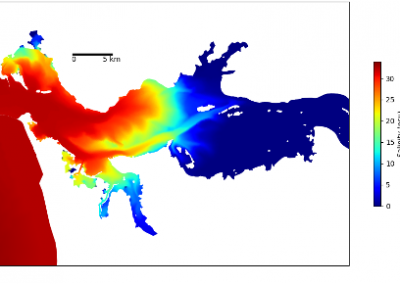Coastal Margin Observation and Prediction (CMOP)
A program of the Columbia River Inter-Tribal Fish Commission
Salmon depend on the Columbia River estuary and coastal ocean
A critically important period in the lifecycle of salmon and lamprey is the time they spend in the Columbia River estuary. It is here that they make their remarkable transition from living in fresh water to salt water and back.
Juvenile salmon can spend up to several months in the estuary before migrating to the ocean. During this time, salmon occupy diverse estuary habitats, including natural wetlands, which are a crucial source of insects for prey. Salmon that spend longer in the estuary tend to have higher survival rates, and salmon benefit from intact estuary habitat, underscoring the importance of estuary habitat restoration efforts.
Before completing their migration in the open ocean, juvenile salmon often spend time in the river plume, the mass of mixed river water and seawater that forms in the ocean from river discharge. The river plume provides a prey-rich environment, and likely plays an important role in salmon survival in the early marine stage. After spending one to five years in the ocean, salmon return to the river plume and estuary. They pause here to transition back to freshwater before continuing their journey to the stream where they were born in order to spawn.
It is the important role that the Columbia River estuary plays in the salmon’s lifecycle that drives CRITFC and its member tribes to further our understanding of this unique and vital ecosystem. In 2020, the Columbia River Inter-Tribal Fish Commission (CRITFC) assumed stewardship of the Center for Coastal Margin Observation and Prediction (CMOP) seeing it as a perfect complement to their efforts to combine cutting edge scientific research with traditional ecological knowledge in the estuary and ocean environments. CMOP, based in Astoria, Oregon, at the mouth of the Columbia River, is a nationally renowned ocean and estuary research program dedicated to further understanding the linkage between the Columbia River and the Pacific Ocean. CMOP uses remote sensors, models, and open data access in ways that help stakeholders manage ecosystems, facilitate sustainable development, and protect lives and livelihoods in our changing environment.
CMOP’s Work
The CMOP observation network consists of buoys and dock-based fixed stations in the estuary and plume. Physical parameters such as salinity, temperature, water levels, and currents have been measured and recorded since 1996 and biogeochemical parameters such as chlorophyll, turbidity, nitrate, and dissolved oxygen since 2008. These measurements provide a record of variability and change in this important ecosystem. CMOP stations can be used for deploying new monitoring equipment and for collecting water samples for lab analysis.

Map of CMOP observation network in the lower estuary and coastal ocean.
CMOP Salmon Connection
CRITFC’s co-management ethos dictates that wherever the salmon go, we go with them. CMOP observations of water temperature and dissolved oxygen are directly relevant for salmon health.
Observations of salinity are important for monitoring the risk of salinity intrusion into freshwater wetland habitat, particularly in the Cathlamet Bay, Oregon.
CMOP modeling has been used to assess the potential effects on salmon due to changes in the Columbia River. CMOP modeling was used to assess potential water management regimes under the next Columbia River Treaty, and to assess the effects of proposed deepening of the Columbia River navigation channel in the early 2000s.
Virtual River Model
CMOP’s numerical model of the Columbia River estuary and coastal ocean (the Virtual Columbia River model) extends from Bonneville Dam to the open ocean. The primary focus is on the lower estuary and the river plume, which extends between 20 to 100 miles out into the ocean. The Virtual Columbia River is run as daily forecasts, 20-year historical simulations (‘hindcasts’), and scenario simulations such as sea level rise, channel deepening, or pre-development bathymetry.
Model outputs are used to create indexes describing the estuary and plume, such as plume volume and salinity intrusion length, and climatology maps of salinity and temperature. Model outputs are also used to create estimates of potential juvenile salmon habitat and used in individual based modeling (IBM) of juvenile salmon migration. A new version of the model will include an improved representation the upper portion of the estuary and could be able to model water quality, sediment transport, and aquatic vegetation.
Virtual river modeling of bottom salinity (left) and surface salinity (right) of the Columbia River estuary.
SCHISM Modeling in the Pacific Ocean Basin
The National Ocean Service’s (NOS) operational ocean forecast models provide coastal flooding model guidance, forcing and boundary conditions for downstream models used by NOAA to forecast extreme weather, rip currents, storm surge, and flooding to protect people and property in the Pacific Ocean Basin. CMOP, in collaboration with NOAA, is developing and enhancing the surface current, tidal, and storm surge simulation capabilities in these models by extending the coverage both at the basin-scale and along the US coast and estuaries. By anchoring the modeling through high-resolution implementations of the unstructured-grid code SCHISM, enhancement of bathymetry, topography, shoreline, tidal gauge and external forcing data and products are being produced that will be integrated into future versions of the Extratropical Surge and Tide Operational Forecast System (ESTOFS).
Future of CMOP
CMOP has a long history operating in the estuary and is a known to the local community and to the regional oceanographic community. Through new partnerships, CMOP plans on expanding the understanding of the linkage between the ocean and estuary, both in terms of how it impacts the region’s salmon runs and quantifying the effects of climate change in this important and delicate ecosystem.

Our co-management ethos dictates that wherever the salmon go, we go with them. [CMOP], alongside public and non-profit partners, brings tribal co-management and vision to the estuary and ocean environments.”
For More Information
Download the CMOP informational booklet.
Charles Seaton, CMOP Coordinator
cseaton@critfc.org
A detailed description of the CMOP system is available in an open access reference paper.

